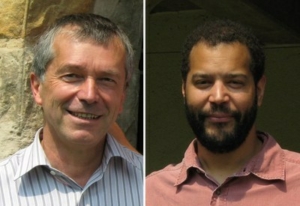Members of SFB 1083 project B4 are co-authors on a new publication in PRL entitled “Coherent Terahertz Control of Vertical Transport in Semiconductor Heterostructures”.
 Members of SFB 1083 project B4 on “Microscopic Theory of Optical Excitations in Interface-Dominated Material Systems” spear-headed by theoretical physicists Professors Stephan W Koch and Mackillo Kira together with their colleagues from Aalto University in Finland (including Osmo Vänskä who recently joined the workgroup as a postdoc here in Marburg) co-authored a new publiction in the journal Physical Review Letters entitled “Coherent Terahertz Control of Vertical Transport in Semiconductor Heterostructures”. It demonstrates a new principle where excitons (Coulomb-bound electron-hole pairs) are selectively moved through a semiconductor interface without moving electrons or holes (electronic vacancies) themselves. This insight
Members of SFB 1083 project B4 on “Microscopic Theory of Optical Excitations in Interface-Dominated Material Systems” spear-headed by theoretical physicists Professors Stephan W Koch and Mackillo Kira together with their colleagues from Aalto University in Finland (including Osmo Vänskä who recently joined the workgroup as a postdoc here in Marburg) co-authored a new publiction in the journal Physical Review Letters entitled “Coherent Terahertz Control of Vertical Transport in Semiconductor Heterostructures”. It demonstrates a new principle where excitons (Coulomb-bound electron-hole pairs) are selectively moved through a semiconductor interface without moving electrons or holes (electronic vacancies) themselves. This insight
provides new principles to applications, such as computers, semiconductor lasers, and solar cells, where it is desirable to selectively move different electronic clusters through material interfaces.
Publication: Osmo Vänskä & al.: Coherent terahertz control of vertical transport in semiconductor heterostructures, Physical Review Letters 114 (2015) 116802, DOI: 10.1103/PhysRevLett.114.116802, URL: https://journals.aps.org/prl/abstract/10.1103/PhysRevLett.114.116802
Read below from the university’s press release in German:
Transport ohne Träger
Theoretische Physiker erweitern die Anwendungsmöglichkeiten von Halbleitern.
Physiker aus Marburg und dem finnischen Aalto haben eine Versuchsanleitung entwickelt, die neue nanotechnische Anwendungen von Halbleitern eröffnet. Demnach ist eine Sequenz elektromagnetischer Pulse in der Lage, Ladungen über die inneren Grenzflächen von Halbleitern zu transportieren, die aus ungleichartigen Materialien bestehen. Das Team veröffentlicht seine Ergebnisse in der aktuellen Ausgabe der Fachzeitschrift „Physical Review Letters“, die am 20. März 2015 erscheint.
„Der Transport von Ladungen über Grenzflächen hinweg ist von entscheidender Bedeutung bei vielen Naturerscheinungen und technischen Anwendungen“, erklärt Mitverfasser Professor Dr. Mackillo Kira von der Philipps-Universität. Das gilt etwa für Solarzellen, aber auch für organische Prozesse wie die Photosynthese, mit der Pflanzen Energie aus Sonnenlicht gewinnen. Solarzellen beruhen auf Halbleitern, die aus mehreren Schichten verschiedener Materialien aufgebaut sind.
Kira und sein Marburger Kollege Professor Dr. Stephan Koch sowie ihre finnischen Partner Dr. Osmo Vänskä und Professor Dr. Ilkka Tittonen wählten als Modell ein Halbleitersystem auf der Basis von Galliumarsenid, das die Beweglichkeit eines Teilchens stark einschränkt, einen so genannten Quantentopf. Sie nutzten einen vor wenigen Jahren entwickelten Theorierahmen für die Quanten-Laserspektroskopie, um zu zeigen, wie ein effizienter Ladungstransfer über innere Grenzflächen hinweg verwirklicht werden kann. Dabei kommen Terahertz-Strahlen zur Anwendung, um den Halbleiter kontrolliert anzuregen.
„Das gelingt derart präzise, dass es sogar möglich ist, quantenmechanische Eigenschaften zu transportieren, ohne Teilchen zu bewegen“, hebt Koautor Koch hervor. Die vorgeschlagene Vorgehensweise ist den Autoren zufolge geeignet, Grenzflächen bei nanotechnologischen Anwendungen zu charakterisieren und deren Eigenschaften nutzbar zu machen.
Professor Dr. Stephan Koch und Professor Dr. Mackillo Kira lehren Theoretische Halbleiterphysik an der Philipps-Universität. Erst vor wenigen Jahren legten sie einen neuen Theorierahmen für die Quanten-Laserspektroskopie vor.
Die aktuelle Veröffentlichung wurde unter anderem von der „Suomen Akatemia“ (Akademie von Finnland) sowie durch den Sonderforschungsbereich (SFB) 1083 der Deutschen Forschungsgemeinschaft an der Philipps-Universität finanziell gefördert. Der SFB vereint mehr als 60 Forscherinnen und Forscher aus Chemie und Physik, die Grenzflächen an einer Vielzahl anorganischer und organischer Festkörper untersuchen, um anhand ihrer Modellsysteme zu einem detaillierten Verständnis der chemischen Bindung, der elektronischen Kopplung und der Energieübertragung zu gelangen.
Originalveröffentlichung: Osmo Vänskä & al.: Coherent terahertz control of vertical transport in semiconductor heterostructures, Physical Review Letters 114 (2015) 116802, DOI: 10.1103/PhysRevLett.114.116802, URL: https://journals.aps.org/prl/abstract/10.1103/PhysRevLett.114.116802
Pressemitteilung zur Theorie der quantenoptischen Spektroskopie: https://www.uni-marburg.de/aktuelles/news/2011/0918a
Pressemitteilung zum SFB 1083: https://www.uni-marburg.de/aktuelles/news/2013b/0524a


 Members of SFB 1083 project B4 on “Microscopic Theory of Optical Excitations in Interface-Dominated Material Systems” spear-headed by theoretical physicists Professors Stephan W Koch and Mackillo Kira together with their colleagues from Aalto University in Finland (including Osmo Vänskä who recently joined the workgroup as a postdoc here in Marburg) co-authored a new publiction in the journal Physical Review Letters entitled “Coherent Terahertz Control of Vertical Transport in Semiconductor Heterostructures”. It demonstrates a new principle where excitons (Coulomb-bound electron-hole pairs) are selectively moved through a semiconductor interface without moving electrons or holes (electronic vacancies) themselves. This insight
Members of SFB 1083 project B4 on “Microscopic Theory of Optical Excitations in Interface-Dominated Material Systems” spear-headed by theoretical physicists Professors Stephan W Koch and Mackillo Kira together with their colleagues from Aalto University in Finland (including Osmo Vänskä who recently joined the workgroup as a postdoc here in Marburg) co-authored a new publiction in the journal Physical Review Letters entitled “Coherent Terahertz Control of Vertical Transport in Semiconductor Heterostructures”. It demonstrates a new principle where excitons (Coulomb-bound electron-hole pairs) are selectively moved through a semiconductor interface without moving electrons or holes (electronic vacancies) themselves. This insight





